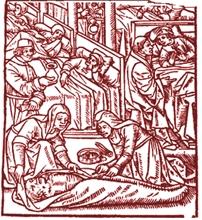Amit Oren

Direct link to this page: https://www.hayadan.org.il/plague240305.html
Devastating plagues that swept through Europe during the Middle Ages were probably unexpectedly beneficial - leaving 10% of Europeans immune to HIV infection.
But viruses of which disease? Researchers claimed this week that the Plague/Black Death helped speed up the population's immunity to the AIDS virus, but rival groups say it should be attributed to smallpox
(Smallpox).
What is clear is that some factor has accelerated the prevalence of a mutation that helps protect against the virus. The mutation, which affects a protein called CCR5 found on the surface of white blood cells, prevents the AIDS virus from entering these cells and causing damage to the immune system.
About 10% of Europeans today carry the mutation, a significantly higher rate than in other populations. Why is it so common in Europe? One possibility is that the mutation helps carriers by protecting them from disease. But genetics researchers know that the mutation, called CCR5-Delta32, appeared about 2,500 years ago - long before the AIDS virus reared its head.
"You need something that has been around for generations," explains Christopher Duncan of the University of Liverpool, UK, who led the latest analysis. The black plague fits the characteristics, he and his colleagues concluded from a mathematical modeling study published in the Journal of Medical Genetics.
Recurrent outbreaks
Duncan's group notes that when the Black Death first struck, killing roughly 40% of Europeans between 1347 and 1350, only one in 20,000 people had the CCR5-Delta32 mutation. As the centuries progressed, repeated outbreaks, culminating in the Great Plague of London in the 1660s, occurred with increases in the frequency of the mutation.
However, other experts are not convinced. A similar study published in 2003 suggests that it was the smallpox disease that accelerated the prevalence of the mutation. "Smallpox would still be my preferred assumption," comments Neil Ferguson, an infectious disease expert at Imperial College London, who was not involved in the study.
Duncan responds that smallpox has only been a serious threat in Europe since the seventeenth century, so there may not have been enough time to cause such a large genetic change. But Ferguson argues that the impact of smallpox over the centuries may have been underestimated, as it largely affected children.
"Smallpox seems like the most parsimonious explanation," he adds. He points out that a particularly big problem with Duncan's Black Plague theory is that it requires rethinking how the plague was caused. If those with a virus-blocking mutation were to survive, then the Black Plague was probably caused by a virus. But the usual assumption is that the Black Plague outbreaks of various kinds during the Middle Ages were caused by a bacterium - Yersinia pestis.
Rats escape from a trap
Duncan admits that his theory is difficult to prove, but he claims that it is easier to explain the outbreaks if it is assumed that the black plague was transmitted directly from person to person as a virus, and not via the "bubonic plague" caused by bacteria carried by rats and their bedbugs. "Rats are absolutely innocent in Europe," he claims.
If this is true, then Duncan could explain not only the average levels of the mutation in Europe, but also the fact that people in Finland and Russia have the highest level, around 16%, while only 4% of Sardinians have it.
He notes that the outbreaks of viral disease accompanied by fever continued in Scandinavia and Russia for a longer time than in the rest of the continent, thus reinforcing the status of the mutation as a valuable asset. "It lasted until 1800 in northern Europe."
For information in Nature
From the Black Death to the smallpox (Avi Blizovsky, website in Eretz HaYada)
The bacteria knower
https://www.hayadan.org.il/BuildaGate4/general2/data_card.php?Cat=~~~116030772~~~165&SiteName=hayadan

One response
This is not understandable at all..!!!